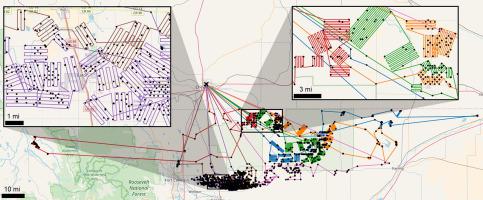Applied Energy ( IF 10.1 ) Pub Date : 2020-06-23 , DOI: 10.1016/j.apenergy.2020.115327 Kashif Rashid , Andrew Speck , Timothy P. Osedach , Dominic V. Perroni , Andrew E. Pomerantz

|
Methane is a short-lived climate pollutant responsible for approximately 20% of anthropogenic global warming, and reducing methane emissions from the oil and gas (O&G) industry is considered among the most urgent and actionable measures to mitigate climate change. Recent reports suggest a large fraction of upstream O&G methane emissions result from a small number of super-emitter facilities, emphasizing the value of novel methods that inspect O&G facilities with greater frequency than is practical using existing techniques. Here we describe an optimized method wherein O&G facilities are inspected for emissions at high frequency and high sensitivity using active laser (LiDAR) sensors mounted to aircraft. The method relies on a hierarchical clustering and routing procedure to establish optimal routes to be flown by aircraft departing from local airports and equipped with LiDAR methane sensors. Routes are optimized to inspect all well sites subject to emissions regulation in three O&G intensive regions: the Permian basin, the state of Colorado, and the state of Pennsylvania. While some cost estimates require additional field data, these modeling results suggest the optimized inspections can be performed with comparable effectiveness and up to a factor of six lower cost per inspection compared to current detection methods. The cost per inspection required to achieve equivalent emissions reduction depends on factors such as the weather conditions during inspection (which impacts the limit of detection and therefore the inspection frequency required to achieve equivalency) and the well density (which impacts the flying distance), and the advantage of this program over traditional inspection will be reduced under unfavorable conditions. These modeling results suggest that optimized routing may enable frequent inspection of upstream O&G facilities at large scale and potentially lead to a substantial decrease in both oilfield methane emissions and compliance costs borne by industry.
中文翻译:

使用机载LiDAR监控优化上游石油和天然气甲烷排放的检查
甲烷是一种短命的气候污染物,约占全球人为变暖的20%,减少石油和天然气(O&G)行业的甲烷排放被认为是缓解气候变化的最紧迫和可行的措施之一。最近的报告表明,上游的O&G甲烷排放量很大一部分是由少量的超级发射器设施引起的,强调了以比使用现有技术实际的频率更高的频率来检查O&G设施的新颖方法的价值。在这里,我们描述了一种优化的方法,其中使用安装在飞机上的有源激光(LiDAR)传感器检查O&G设备在高频和高灵敏度下的排放。该方法依靠分层聚类和路由程序来建立由本地机场出发并配备LiDAR甲烷传感器的飞机要飞行的最佳航线。对路线进行了优化,以检查三个O&G密集区域中受排放监管的所有井场:二叠纪盆地,科罗拉多州和宾夕法尼亚州。尽管某些成本估算需要更多的现场数据,但这些建模结果表明,与当前的检测方法相比,可以以可比的有效性执行优化的检测,并且每次检测的成本最多降低六倍。达到等效减排所需的每次检查成本取决于多种因素,例如检查过程中的天气条件(这会影响检测极限,从而影响达到等效性所需的检查频率)和井密度(会影响飞行距离),以及在不利条件下,该程序相对于传统检查的优势将减少。这些建模结果表明,优化的路线安排可以实现对大型上游O&G设施的频繁检查,并有可能导致油田甲烷排放量和行业承担的合规成本大幅降低。并且在不利条件下,该程序相对于传统检查的优势将会减少。这些建模结果表明,优化的路线安排可以实现对大型上游O&G设施的频繁检查,并有可能导致油田甲烷排放量和行业承担的合规成本大幅降低。并且在不利条件下,该程序相对于传统检查的优势将会减少。这些建模结果表明,优化的路线安排可以实现对大型上游O&G设施的频繁检查,并有可能导致油田甲烷排放量和行业承担的合规成本大幅降低。











































 京公网安备 11010802027423号
京公网安备 11010802027423号